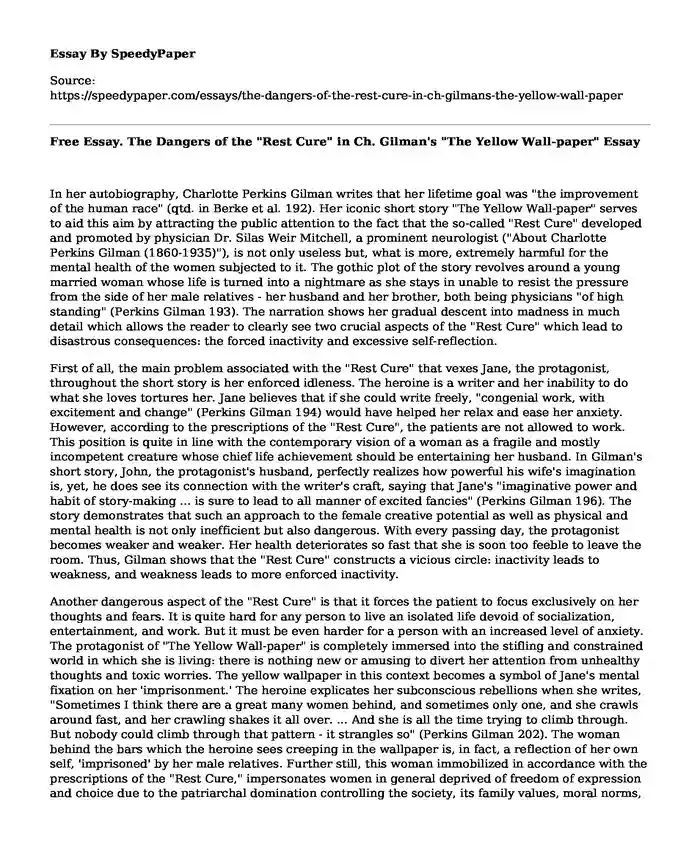
| Type of paper: | Essay |
| Categories: | Women Gender Stereotypes The Yellow Wallpaper |
| Pages: | 3 |
| Wordcount: | 799 words |
In her autobiography, Charlotte Perkins Gilman writes that her lifetime goal was "the improvement of the human race" (qtd. in Berke et al. 192). Her iconic short story "The Yellow Wall-paper" serves to aid this aim by attracting the public attention to the fact that the so-called "Rest Cure" developed and promoted by physician Dr. Silas Weir Mitchell, a prominent neurologist ("About Charlotte Perkins Gilman (1860-1935)"), is not only useless but, what is more, extremely harmful for the mental health of the women subjected to it. The gothic plot of the story revolves around a young married woman whose life is turned into a nightmare as she stays in unable to resist the pressure from the side of her male relatives - her husband and her brother, both being physicians "of high standing" (Perkins Gilman 193). The narration shows her gradual descent into madness in much detail which allows the reader to clearly see two crucial aspects of the "Rest Cure" which lead to disastrous consequences: the forced inactivity and excessive self-reflection.
First of all, the main problem associated with the "Rest Cure" that vexes Jane, the protagonist, throughout the short story is her enforced idleness. The heroine is a writer and her inability to do what she loves tortures her. Jane believes that if she could write freely, "congenial work, with excitement and change" (Perkins Gilman 194) would have helped her relax and ease her anxiety. However, according to the prescriptions of the "Rest Cure", the patients are not allowed to work. This position is quite in line with the contemporary vision of a woman as a fragile and mostly incompetent creature whose chief life achievement should be entertaining her husband. In Gilman's short story, John, the protagonist's husband, perfectly realizes how powerful his wife's imagination is, yet, he does see its connection with the writer's craft, saying that Jane's "imaginative power and habit of story-making ... is sure to lead to all manner of excited fancies" (Perkins Gilman 196). The story demonstrates that such an approach to the female creative potential as well as physical and mental health is not only inefficient but also dangerous. With every passing day, the protagonist becomes weaker and weaker. Her health deteriorates so fast that she is soon too feeble to leave the room. Thus, Gilman shows that the "Rest Cure" constructs a vicious circle: inactivity leads to weakness, and weakness leads to more enforced inactivity.
Another dangerous aspect of the "Rest Cure" is that it forces the patient to focus exclusively on her thoughts and fears. It is quite hard for any person to live an isolated life devoid of socialization, entertainment, and work. But it must be even harder for a person with an increased level of anxiety. The protagonist of "The Yellow Wall-paper" is completely immersed into the stifling and constrained world in which she is living: there is nothing new or amusing to divert her attention from unhealthy thoughts and toxic worries. The yellow wallpaper in this context becomes a symbol of Jane's mental fixation on her 'imprisonment.' The heroine explicates her subconscious rebellions when she writes, "Sometimes I think there are a great many women behind, and sometimes only one, and she crawls around fast, and her crawling shakes it all over. ... And she is all the time trying to climb through. But nobody could climb through that pattern - it strangles so" (Perkins Gilman 202). The woman behind the bars which the heroine sees creeping in the wallpaper is, in fact, a reflection of her own self, 'imprisoned' by her male relatives. Further still, this woman immobilized in accordance with the prescriptions of the "Rest Cure," impersonates women in general deprived of freedom of expression and choice due to the patriarchal domination controlling the society, its family values, moral norms, generally accepted gender roles, which are reflected in the development of the contemporary medicine.
In her short story "The Yellow Wall-paper," Charlotte Perkins Gilman employs her outstanding writing talent to expose the dangers of the "Rest Cure" as a nonsensical and perilous medical practice. The author convincingly shows that while enforced inactivity causes increased weakness and atonia, the absence of diversions leads to excessive introspection and fixation on unhealthy thoughts. More than that, by exposing the dangers of the "Rest Cure," Gilman is also challenging the validity of the gender stereotypes, imposed on women by the patriarchal society.
Works Cited
"About Charlotte Perkins Gilman (1860-1935)." 2020. PDF file.
Berke, A., Bleil, R. R., Cofer, J., & Davis, D. (2016). Charlotte Perkins Gilman. In Writing the Nation: A Concise Introduction to American Literature 1865 - Present (pp. 192-193). Dahlonega, Georgia: University of North Georgia, University Press.
Perkins Gilman, C. (2016). "The Yellow Wall-Paper." In Writing the Nation: A Concise Introduction to American Literature 1865 - Present (pp. 193-205). Dahlonega, Georgia: University of North Georgia, University Press.
Cite this page
Free Essay. The Dangers of the "Rest Cure" in Ch. Gilman's "The Yellow Wall-paper". (2023, May 02). Retrieved from https://speedypaper.com/essays/the-dangers-of-the-rest-cure-in-ch-gilmans-the-yellow-wall-paper
Request Removal
If you are the original author of this essay and no longer wish to have it published on the SpeedyPaper website, please click below to request its removal:
- Should Electronics Be Allowed in School. Free Essay Example.
- Essay Sample on the Role of Israeli Jewish Women on Religion in Modern Times
- Marketing Management - Vlog Script, Free Paper Sample for You
- HRM Essay Sample about Employment Strategy
- Free Essay on The Origin of The Earth
- Free Essay on the BBC Film Adaptation of Dickens' Mystery of Edwin Drood
- Paper Example. Ethics Failures in a Business
Popular categories




